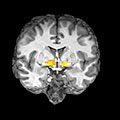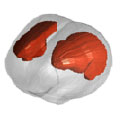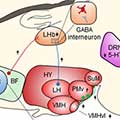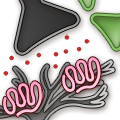Hot Off the Press – October 28, 2019. Approximately 1.1 billion people smoke cigarettes worldwide. More than half of these are expected to die of smoking-related diseases. According to the US Centers for Disease Control: most smokers (68%) want to quit; about half (54%) try to quit each year; yet very few (about 7%) do… [Read More]
News Main
Intrinsic Insular-Frontal Networks Predict Future Nicotine Dependence Severity.
Featured Paper of the Month – October 2019
Published in The Journal of Neuroscience by Hsu, Li-Ming; Keeley, Robin J; Liang, Xia; Brynildsen, Julia K; Lu, Hanbing; Yang, Yihong; Stein, Elliot A
Smoking remains a major public health burden, with approximately 20% of the world’s population engaging in regular smoking. Given the high relapse rate among smokers who enter treatments programs, early identification of vulnerable individuals, before the conversion from casual experimentation to regular smoking and addiction, is an important milestone to understand, prevent and potentially minimize nicotine dependence. Using a rodent model of nicotine dependence, we developed a quantitative predictor of subsequent nicotine dependence severity using graph theory-based analyses of fMRI BOLD resting state data collected at baseline, prior to any drug experience…
Eliot Gardner Presented with Lifetime Achievement Award
Eliot Gardner received the Lifetime Achievement Award from the International Drug Abuse Research Society at its most recent meeting in Casablanca, Morocco. The award was presented to Dr. Gardner by the Prime Minister of Morocco, Saadeddine Othmani. Dr. Gardner was honored for his lifetime of groundbreaking research in the field of Neuropsychopharmacology at The NIDA… [Read More]
Altered corticolimbic control of the nucleus accumbens by chronic Δ9-Tetrahydrocannabinol Exposure
Hot Off the Press – September 3, 2019. The expanding legalization of recreational and medical marijuana has increased its availability, and stronger strains of cannabis containing much higher levels of ∆9-tetrahydrocannabinol (THC), the primary psychoactive constituent, are now widely used. Although the effects of marijuana on the brain are often assumed to be mild, there… [Read More]
Novel and Potent Dopamine D 2 Receptor Go-Protein Biased Agonists.
Featured Paper of the Month – September 2019
Published in ACS Pharmacology & Translational Science by Bonifazi, Alessandro; Yano, Hideaki; Guerrero, Adrian M; Kumar, Vivek; Hoffman, Alexander F; Lupica, Carl R; Shi, Lei; Newman, Amy Hauck
The discovery of functionally biased and physiologically beneficial ligands directed toward G-protein coupled receptors (GPCRs) has provided the impetus to design dopamine D2 receptor (D2R) targeted molecules that may be therapeutically advantageous for the treatment of certain neuropsychiatric or basal ganglia related disorders. Here we describe the synthesis of a novel series of D2R agonists linking the D2R unbiased agonist sumanirole with privileged secondary molecular fragments. The resulting ligands demonstrate improved D2R affinity and selectivity over sumanirole…
Amy Newman Wins the 2019 Ruth L. Kirschstein Mentoring Award
On July 15, 2019, Dr. Francis S. Collins presented our own Dr. Newman with the 2019 Ruth L. Kirschstein Mentoring Award. The Ruth L. Kirschstein Mentoring Award is given to individuals who have demonstrated significant leadership, skill, and ability in serving as mentor to one or more individuals. It was initiated to give formal recognition,… [Read More]
Discriminative stimuli are sufficient for incubation of cocaine craving.
Featured Paper of the Month – August 2019
Published in Elife by Madangopal, Rajtarun; Tunstall, Brendan J; Komer, Lauren E; Weber, Sophia J; Hoots, Jennifer K; Lennon, Veronica A; Bossert, Jennifer M; Epstein, David H; Shaham, Yavin; Hope, Bruce T
In abstinent drug addicts, cues formerly associated with drug-taking experiences gain relapse-inducing potency (‘incubate‘) over time. Animal models of incubation may help develop treatments to prevent relapse, but these models have ubiquitously focused on the role of conditioned stimuli (CSs) signaling drug delivery. Discriminative stimuli (DSs) are unique in that they exert stimulus-control over both drug taking and drug seeking behavior and are difficult to extinguish. For this reason, incubation of the excitatory effects of DSs that signal drug availability, not yet examined in preclinical studies, could be relevant to relapse prevention…
2020 NIDA IRP FARE winners
Congratulations to our 2020 FARE (Fellows Award for Research Excellence) winners! They will each receive a $1500 travel stipend to attend a meeting next fiscal year to present their research. They will also give a talk at the Baltimore Fellows Symposium on October 10, 2019. Congratulations to our 2020 FARE winners (left to right): Alessandro… [Read More]
Animal Models of (or for) Aggression Reward, Addiction, and Relapse: Behavior and Circuits.
Reviews To Read – July 2019. Inappropriate and pathological aggression plays a leading role in the suffering and death of millions of people, and further places an untenable strain on the caregivers and families of those afflicted. In some cases, like addictive drugs, aggression can be highly rewarding (appetitive) and continually pursued despite short- and… [Read More]
High-Frequency Activation of Nucleus Accumbens D1-MSNs Drives Excitatory Potentiation on D2-MSNs.
Hot Off the Press – June 16, 2019. Brain stimulation is used to treat reward-related psychiatric diseases including addiction and treatment resistant depression. We report that high frequency stimulation parameters effective in treating these diseases promote the release of the peptide substance P. Release of this peptide in the Nucleus Accumbens rebalances excitatory input to… [Read More]










